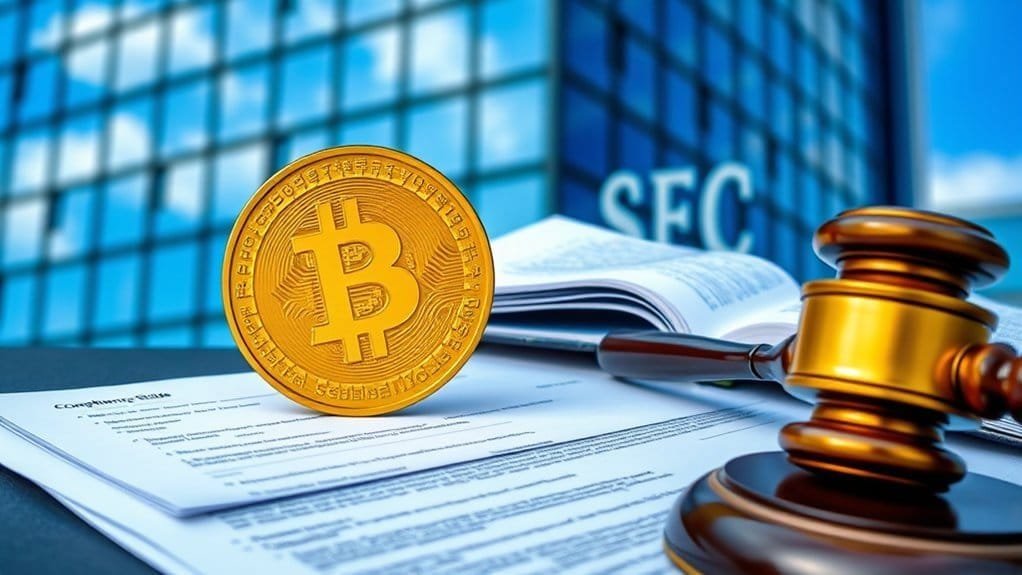The SEC just ditched SAB 121 for the more flexible SAB 122. Big change. This shift focuses on general accounting principles instead of crypto-specific rules. Commissioner Peirce’s task force is gathering industry input to develop an all-encompassing structure. Fully-backed USD stablecoins get a break, while custodial entities have more breathing room. Crypto assets compliance remains tough, though. Companies are rushing to adapt their practices as regulators ultimately attempt to keep pace with the digital and crypto assets revolution.

How exactly are crypto companies supposed to maneuver the regulatory maze? The SEC seems to have ultimately decided that maybe obliterating the industry through enforcement actions isn’t the best approach. They’ve rescinded SAB 121 in favor of the more flexible SAB 122, focusing on general accounting principles rather than crypto-specific regulations. About time.
The new guidance provides breathing room for custodial entities handling crypto assets. Instead of dictating every move, the SEC is actually asking for industry feedback. Shocking, right? They’re considering temporary measures for custody arrangements until permanent rules are established. This shift was led by SEC Commissioner Hester Peirce’s task force which aims to create a comprehensive regulatory framework for crypto assets compliance .
Special-purpose broker-dealers handling digital asset securities already have some guidance to work with. But let’s be real—distinguishing between security tokens and other tokens remains a headache.
Some good news for stablecoin issuers. Certain USD-pegged stablecoins can avoid SEC registration if they’re fully backed by reserves and marketed solely for payments, not as investments. The guidance specifically requires these stablecoins to be redeemable on demand at a one-to-one basis with USD. No promises of profit, no governance rights, no yield—no security classification. Even BUSD got this treatment. Not all stablecoins qualify, though. Structure matters.
The SEC’s Crypto Task Force is gathering public input to develop a thorough framework. They’re looking at crypto taxonomy, public offerings, and possibly creating a safe harbor for blockchain projects. They claim they want a “technology-neutral” and “economically rational” approach. We’ll see.
Compliance remains a nightmare for digital asset companies. Non-compliance? Expect enforcement actions and hefty fines. Many firms are turning to RegTech solutions to keep up with the constantly shifting environment.
On the accounting front, the SEC is aligning with GAAP and IFRS standards. Companies need to disclose risks associated with safeguarding crypto assets and account for potential loss liabilities.
The Financial Accounting Standards Board is involved too. Progress, but still complex. The industry keeps changing. Regulators are ultimately trying to catch up. Maybe.
Frequently Asked Questions
What Penalties Could Firms Face for Non-Compliance?
Non-compliant firms face steep penalties. Civil monetary fines, disgorgement of profits, and prejudgment interest are standard.
Just look at Galois Capital—slapped with $225,000 for using unqualified custodians like FTX. Half their crypto assets, gone.
Total crypto enforcement penalties have hit $7.84 billion since 2013. The SEC isn’t playing around.
They’ve filed 207 crypto-related actions, with restrictions on trading and even total shutdowns.
How Quickly Must Companies Adapt to These New Guidelines?
Companies need to move fast. The SEC isn’t exactly known for its patience.
Most firms have weeks to months—not years—to implement changes, depending on their specific operations and the SEC’s enforcement priorities.
Smaller players might struggle with compliance costs. Guess what? Too bad. The feds don’t care about your budget constraints.
Companies with higher risk profiles should prioritize immediate adaptation to avoid becoming regulatory examples.
Will These Regulations Affect International Cryptocurrency Trading Platforms?
International crypto platforms will definitely feel the heat.
These regulations don’t stop at borders. Global platforms will need to align with FATF standards while juggling cross-border requirements. Compliance costs? Through the roof.
Some platforms might get locked out of certain markets entirely if they don’t play ball. It’s a regulatory patchwork nightmare.
The SEC’s shift toward clearer rules could actually set trends for global oversight, though.
Are There Exemptions for Smaller Cryptocurrency Startups?
Yes, smaller crypto startups have several potential exemptions. Regulation A+ allows fundraising from all investor types, with Blockstack being a notable success story.
The SEC is also considering NFT fundraising exemptions and temporary relief for unregistered proposals that provide required information. These exemptions create an uneven playing field, though.
Compliance costs remain steep regardless – setting up AML/KYC infrastructure isn’t cheap. Regulatory uncertainty persists despite clarification efforts.
How Do These Guidelines Compare to Crypto Regulations in Europe?
Europe’s crypto rules are more thorough than the SEC’s piecemeal approach.
The EU’s Markets in Crypto-Assets (MiCA) system creates uniform standards across member states – something the US lacks entirely.
While the SEC offers exemptions for specific stablecoins, Europe demands stricter reserve requirements across the board.
The SEC’s guidance? Still developing, case-by-case.
Europe? Already built a structured regulatory house.
Americans are playing catch-up, frankly.

